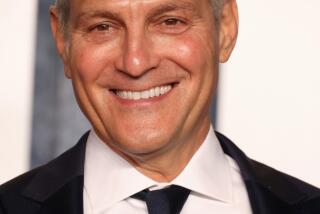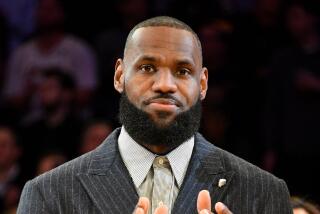MTV Whiz Jumps From Hyperactive to Interactive : Entertainment: The free-spirited John A. Lack must persuade cable firms to try the new hands-on TV technology.
- Share via
For most of his life, John A. Lack has created a stir.
Kicked out of prep school at 16, made general manager of New York’s WCBS-AM Radio at age 32, Lack coaxed $25 million out of Warner Communications Inc. and American Express in 1981 to launch MTV, the rock ‘n’ roll cable network.
Lack left MTV’s parent company just two years later, looking for ventures that offered a significant ownership stake. He scored one hit (radio stations) and one miss (video vending machines). Now he’s taken on the job of running ACTV Inc., an interactive television company that has attracted big-name investors but is still trying to win acceptance among cable companies.
Can Lack, at 47, score another coup of MTV’s magnitude?
The test may come soon in Los Angeles, where the regional sports channel Prime Ticket Network is negotiating to use the ACTV system on a trial basis this fall. In a few thousand cable TV homes, subscribers will be offered the chance to pay a fee each month for an interactive service allowing them to select camera angles, statistical information or tapedreplays.
“No firm pricing or other programming decisions have been made yet,” says Roger Werner, president and chief executive of Prime Sports Ventures, the holding company for Prime Ticket Network’s controlling shareholder.
The test areas have yet to be chosen. But Werner, a former president of ESPN, says he wants to evaluate the ACTV system for six months or more. “We’re extremely excited about it,” he says.
ACTV is also angling to participate in an interactive games channel for cable television. To that end, Lack is trying to persuade Mel Harris, television group president for Sony Pictures Entertainment, to use ACTV technology when Sony launches the Game Show Channel next year with United Video Satellite Group.
There’s no question that ACTV’s technology works. Since early 1990, Montreal-based Le Groupe Videotron Itee has been using ACTV-patented technology in its Videoway system, which provides cable TV subscribers videotex services, video games and interactive programming. In its 1991 annual report, Groupe Videotron predicted that the system will become profitable this year, with subscriber acceptance approaching 20% of the eligible cable TV homes.
ACTV programs are sent via four cable channels. Decoder boxes equipped with an ACTV semiconductor chip and tuner allow for “seamless” switching when a viewer pushes one of four buttons on the remote control device. With the push of the button, the picture on the television set changes. The system is so simple--and inexpensive compared to compact discs--that some school boards have purchased it.
In the commercial marketplace of cable television, however, ACTV has faced significant hurdles, because it requires four video channels if it is to be used to its full advantage. Few cable TV systems have channels to spare. That will change as cable TV companies rebuild their systems with improved fiber-optic and signal compression to open up hundreds of new channels. Until then, ACTV says, its system will work satisfactorily with a single video channel, graphic overlays and multiple audio channels.
Meanwhile, competing systems are cropping up, and ACTV is thinly capitalized. If it is to establish a beachhead in the United States, the New York company must align itself with powerful programming partners. That’s why ACTV founder and inventor Michael J. Freeman recruited Lack a year ago as president and chief executive. As part of his employment agreement, Lack has options to acquire 17% of ACTV’s stock.
Lack is “a natural salesman,” according to William Grimes, a veteran media executive who gave Lack his first sales job at CBS Radio in 1970. “He’s persistent; he’s persuasive. When John believes in something, he’s a zealot.”
Grimes describes Lack as generous to charities as well as friends. When Grimes recently was named president of Multimedia Inc., Lack honored him with his usual flourish, reserving a private dining room at the Four Seasons in New York to celebrate.
Lack has frequented Manhattan’s toniest restaurants since childhood. The legendary “21” remains a favorite haunt, just as it appealed to his father, Jules Lack. “Big Julie,” as Time Magazine called the father in 1954, was “a big, gregarious playboy . . . (who) spent most of his time hobnobbing with the rich and famous at the bar in ‘21,’ the Pump Room, or kindred establishments in New York, Chicago and Miami.”
Unfortunately, the Time Magazine story was prompted by Jules Lack’s murder that year. John was 9; his parents were already divorced, but the homicide created a sensation because “Big Julie” was gunned down by a jealous husband who tracked him to a Lake Michigan house party.
Lack remembers his father as a “Damon Runyon character” who had varied success in the air-conditioning and carpeting businesses, yet was so generous that he would borrow money from a third party if he couldn’t meet a friend’s request for a loan.
Like father, like son? Lack concedes the possibility. He takes his own business reversals in stride, saying, “As Mike Todd said, ‘I’ve been broke many times, but never poor. Poor is a state of mind.’ ”
Lack is a raconteur, telling stories on himself with ease. He was expelled from prep school, for example, for drinking from his championship cup after winning a state wrestling event. He later graduated from a Rhode Island boarding school and Boston University, going on to Northwestern University for a master’s degree in journalism.
Recruited by Westinghouse Broadcasting in 1967 for a management training program, Lack landed in Philadelphia, where he completed his course work for a Ph.D. in communications at the University of Pennsylvania. After a stint as program manager at a Baltimore radio station, he appeared in Bill Grimes’ office in 1970, looking for work.
“He was a striking figure even then; he was probably making $15,000 a year but dressed impeccably,” Grimes recalls. “He established terrific rapport with his customers; there was hardly an evening when he wasn’t entertaining his customers at ’21.’ ”
After a series of promotions in radio sales, Grimes named Lack vice president and general manager of WCBS-AM in 1977. Then, in 1979, Warner Communications Inc. lured him away by trebling his salary and giving him the chance to develop cable TV networks.
Lack worked first on Warner’s QUBE system, an early interactive TV system tested in Columbus, Ohio. From there, he took a local preschoolers’ show to New York, helping launch Nickelodeon in mid-1979.
Then, after American Express Co. bought a stake in Warner’s cable TV business, he moved to the programming arm called Warner Amex Satellite Entertainment Co. as chief operating officer. There, Lack pushed to make the Movie Channel the first 24-hour movie service and launched MTV. He needed $25 million to start the service, and perhaps his greatest coup was persuading Warner Chairman Steven J. Ross and American Express Chairman James Robinson to back the venture.
“He (could) sell you the Brooklyn Bridge,” says Margaret Wade, a Warner consultant who once worked for Lack as a Warner Amex vice president. “And his best talent, without a doubt, was in hiring people, based on the people he pulled together to run those channels.”
Two of the hires: Thomas Freston, the current MTV Networks chairman, and programming whiz Robert W. Pittman, now chief executive of Time Warner Enterprises.
But by early 1983, both American Express and Warner were having second thoughts about the cost of expanding rapidly in cable. Warner was hemorrhaging from losses in its Atari subsidiary. Lack left Warner Amex by “mutual” consent with a generous two-year settlement that enabled him to travel to China and England, then spend four months on his farm.
In 1984, he became a co-owner of ELF Communications Inc. (“a giant in broadcasting,” he quips) with Jay Emmett, a former member of Warner’s office of the president who had made headlines by pleading guilty in 1981 to two criminal charges of transporting stolen checks. Lack put up no cash but walked away with a $1-million profit after turning around a group of radio stations and selling them 18 months later.
Lack decided to invest his $1 million in the video vending machine business, and became president and chief executive of Nelson Vending Technology Ltd. of Canada. For four years, he shuttled from New York to Toronto, where Nelson installed over 350 machines in subways, grocery stores and other high-traffic locations.
The company has run through $50 million so far; Lack still holds his stake, but the stock has traded for less than 10 cents (Canadian) per share for the last year on the Toronto exchange, down from a 52-week high of 39 cents (Canadian) in 1990.
“Whether it ever becomes a business, I don’t know,” says Lack, who gave up his operating role last year to accept the job at ACTV.
Organized in 1983, ACTV has attracted a number of high-profile investors during its long gestation. One of the first was Nolan Bushnell, the Atari founder, who pumped about $1.5 million in ACTV and served on the board until mid-1985. “I looked at the technology and liked it; still do,” says Bushnell, who praises the selection of Lack as president. “The key to the company is to get some key partners, and I think John can bring them in.”
Bushnell still holds his ACTV stock, but another ground-floor investor--Leisure Concepts Inc.--sold its stake last year at a loss.
No one is profiting yet. The company has accumulated losses of $13 million but has managed to pay its bills by a series of financings and the sale of systems to educational and training facilities. ACTV raised nearly $4 million, for example, by going public in 1990.
In March, the Washington Post Co. loaned $1.5 million to ACTV in exchange for 15% of its shares and the right to acquire 51% of ACTV’s training and educational business. If the Post exercises its rights later this month, it will pay ACTV an additional $2.5 million for the 51% stake in the education subsidiary.
Some analysts assumed that the Post would consider the technology for its Stanley H. Kaplan Educational Centers, which prepare students for admissions tests and licensing examinations, but a Post executive says the company’s interest is broader than that.
The Post must decide by November whether to invest $2 million in ACTV’s entertainment division. If it does, it would eventually be entitled to increase its stake to a majority holding of the parent company, under terms of the March agreement.
Meanwhile, competitors such as Interactive Network Inc. have attracted big-name investors as well. NBC holds a 17.5% stake in that Mountain View, Calif.-based company, which has lost more than $16 million. Interactive Network uses telephone lines and the unused portion of certain FM radio bands to transmit its signal. For now, the company says it will market the product only in the San Jose-San Francisco and Sacramento areas.
Another comer: TV Answer, based in Reston, Va., which plans to transmit its interactive programming by satellite and newly allocated radio spectrum. But the system looks expensive and might only facilitate transactions that can already be completed by telephone.
Bushnell, for one, maintains that newer technologies have not surpassed ACTV’s “price performance” capability. Indeed, Lack boasts that the hardware required for the decoder box costs no more than $8 for the ACTV semiconductor and tuner.
Bushnell says he studied the underlying technology closely before investing in 1983, and expresses the belief that Freeman’s inventive work was “early enough and clever enough” to make the ACTV patents “very secure.”
More to Read
The biggest entertainment stories
Get our big stories about Hollywood, film, television, music, arts, culture and more right in your inbox as soon as they publish.
You may occasionally receive promotional content from the Los Angeles Times.










